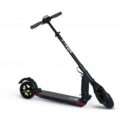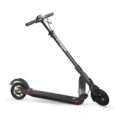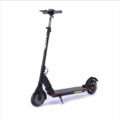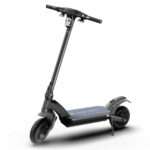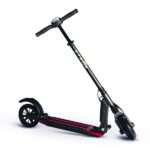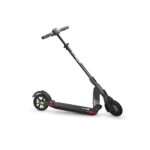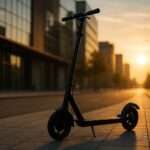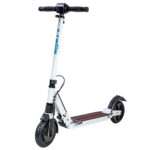- Home
- Scooters
- Electric Scooters
- E-TWOW GT SL
E-TWOW GT SL
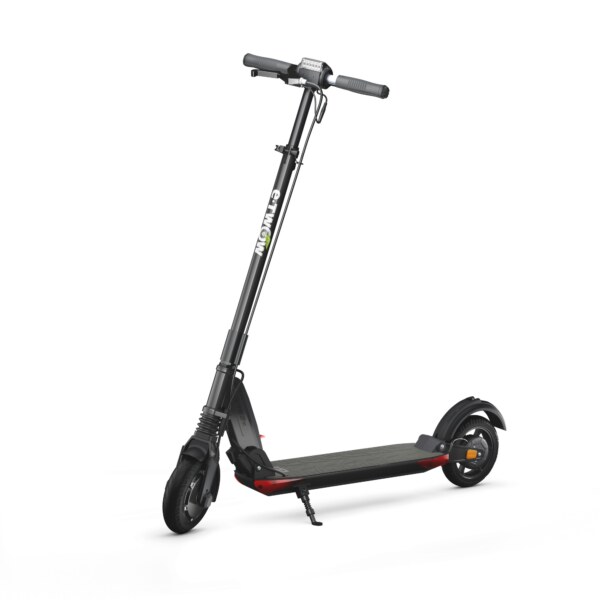

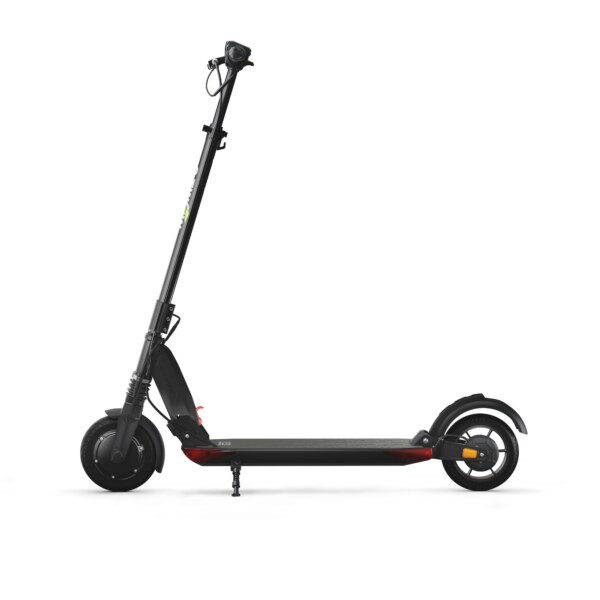
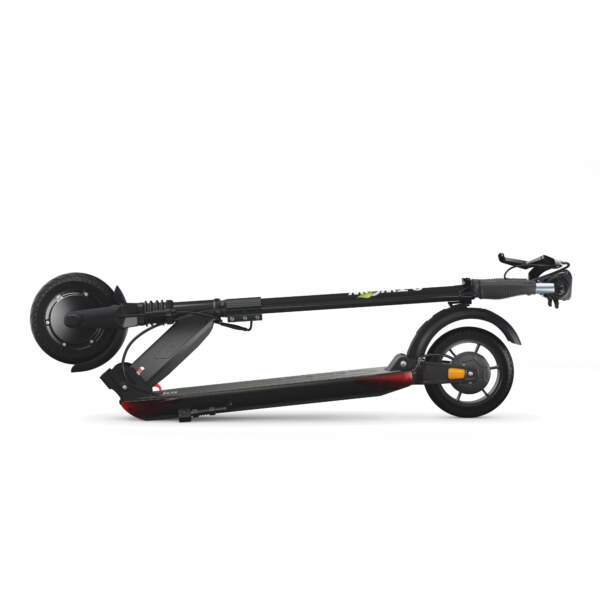
- Battery Range: 22–25 miles (35–40 km)
- Top Speed: 25 mph (40 km/h)
- Motor Power: 500 W
- Weight Capacity: 242 lb (110 kg)
- Charging Time: ~3–4 h
- Scooter Weight: 29.0 lb (13.2 kg)
PROS
- Light 29 lb class for easy carry
- 500 W motor with regen braking
- Rear drum brake plus front electronic brake
- Front & rear suspension
- Bluetooth app with lock and speed-limit
CONS
- 35–40 km real-world range window
- Small 8″ solid tires reduce comfort
- IP rating not specified
Key Takeaways
- The E-TWOW GT SL is a compact, lightweight commuter scooter designed for urban use, featuring solid rubber tires for flat protection.
- It utilizes a 500 W motor and has a 48 V lithium battery that offers a range of 14–20 miles depending on conditions.
- The scooter folds quickly for easy transport and storage, weighing just 29.1 lb, making it ideal for multi-modal commutes.
- Key safety features include front electronic regenerative braking and a rear drum brake for reliable stopping power.
- This model excels in city riding but is not suitable for rough terrain or long-distance rides.
Table of contents
- What Is the E-TWOW GT SL?
- How the E-TWOW GT SL Works
- Key Specifications
- Design & Build Quality
- Performance Fundamentals
- Battery, Range & Efficiency
- Ride Quality & Comfort
- Braking & Safety Features
- Portability & Daily Usability
- Maintenance & Care
- Weather & Seasonal Considerations
- E-TWOW GT SL vs Alternatives
- Who the E-TWOW GT SL Is (and Isn’t) For
- FAQs
- Glossary
The E-TWOW GT SL is a compact, quick, and light commuter scooter for busy streets. It favors fast takeoffs, short charge stops, and easy carrying. If you want real speed in a small frame, this fits. And it keeps weight low while protecting the basics that matter for daily rides.
What Is the E-TWOW GT SL?
This model lives in the GT Line. It runs a 48-volt system, a 500-watt front hub, and a 7.8-Ah lithium pack. A rear drum backs up the well-known E-TWOW regen lever. The fold stays classic, the bar height adjusts in seconds, and the 8-inch airless tires shrug off punctures. So you get a slim, sturdy commuter that folds fast and hides under a desk.
Who will like it most? City riders who put light weight and day-to-day dependability over big-wheel plush. The GT SL trades tubes for solid rubber. So you skip flats and weekly pressure checks. You gain a firmer road feel, which helps at pace on clean pavement.
How the E-TWOW GT SL Works
Think of it as a simple electric drive inside a tidy folding frame. Each control does one job. So the learning curve is short.
- Motor. A brushless DC hub in the front wheel delivers 500 W and short peak bursts. The single-speed layout stays quiet and direct. And the sealed hub cuts routine work.
- Controller. A compact unit manages current, regen strength, and the speed limit you choose on the display or app. It reads throttle and brake inputs many times per second. So power ramps feel smooth and predictable.
- Battery. A 48 V, 7.8 Ah pack sits low in the deck for balance. Total energy is about 374 Wh. The battery-management system protects the cells during charge and discharge. And the closed deck helps keep dust and splash away.
- Throttle. A right-thumb lever calls for power. Small presses deliver gentle roll-on. A full press gives brisk launches from a stop. So crowded paths still feel calm if you feather the lever.
- Brakes. A left electronic lever adds magnetic braking on the front hub. A second lever runs the rear drum. Use both together when you need a short, straight stop. And use light regen for most slowdowns to save the shoes.
Key Specifications
The details below reflect the official model sheet for GT SL. Values appear in US units with metric in parentheses. These specifications set clear expectations before your first ride.
General
| Item | Value |
|---|---|
| Model | E-TWOW GT SL |
| Intended use | Urban commuting on paved routes |
| Rider weight limit | 242 lb (110 kg) |
| Net weight | 29.1 lb (13.2 kg) |
| Wheel size | 8 in (200 mm) airless rubber |
| Handlebar | Height-adjustable with foldable grips |
| Drive | Front-wheel hub motor |
Performance & Power
| Item | Value |
|---|---|
| Nominal motor power | 500 W (brushless DC) |
| Peak motor power | ~700 W |
| Top speed (factory rating) | 21.7 mph (35 km/h) |
| Rated climb ability | 25° on short ramps |
Battery, Charging & Electrical
| Item | Value |
|---|---|
| System voltage | 48 V |
| Battery capacity | 7.8 Ah (≈ 374 Wh) |
| Charger | 54.6 V, 2 A or 3 A |
| Charge time | ~3–4 hours |
| BMS | Over-current, over-charge, under-voltage protection |
Build & Dimensions
| Item | Value |
|---|---|
| Frame material | Aluminum alloy |
| Folded size | 41.7 × 13.0 × 5.7 in (1060 × 330 × 146 mm) |
| Expanded size | 44.5 × 45.9 × 15.2 in (1130 × 1167 × 386 mm) |
| Kickstand | Side stand |
Safety & Control
| Item | Value |
|---|---|
| Brakes | Front electronic regen + rear drum |
| Headlight | Front LED |
| Rear lights | Tail/brake light |
| Reflectors | Side reflectors on frame |
| Speed limit modes | Selectable on display |
| Start mode | Zero-start on/off selectable |
Features & Extras
| Item | Value |
|---|---|
| App | E-TWOW Connect (Bluetooth) |
| Display | Backlit LCD: speed, distance, battery, temp |
| Suspension | Front and rear spring units |
| Cruise control | Not listed for GT SL in official notes |
| Tires | Patented airless rubber, puncture-proof |
Warranty & Compliance
| Item | Value |
|---|---|
| Compliance | Supplied with EU conformity documents |
| Warranty process | Through authorized dealers under local law |
| Water guidance | Avoid heavy rain and water over ~1.5 in (4 cm). Deep water can void warranty. |
Design & Build Quality
The frame uses a stiff aluminum spine with a clean deck shell. The deck is narrow to help quick stance changes in traffic. Grip tape holds shoes even when the surface gets dusty. And the edges feel smooth against ankles when you pivot in tight spots.
The stem locks with the usual E-TWOW clamp and lower lever. The lever closes with a firm snap, then stays quiet over rough blocks. The cockpit keeps things simple. The thumb throttle sits on the right. The left side hosts the regen lever and light button near the display keys. And the bar ends fold in, which helps when you slip the scooter between seats or under a cafe table.
Bar height adjusts in seconds. So tall riders can get a stable reach without slouching. Fit and finish look tidy with even gaps and tucked cables. The small kickstand is steady on flat ground. It sits clear of the deck edge, so your shoe does not snag when you step off.
Performance Fundamentals
The GT SL jumps off the line with a clean hit up to medium pace. Throttle mapping feels smooth for crowded paths if you stay light on the lever. And the scooter holds speed well on level streets. Above 18–20 mph, stance and road grip start to matter more than raw power. So keep your weight steady over the front when the surface gets bumpy.
What about hills? Short city grades in the 7–10% range fit the motor and gearing. Starts on a 7% hill feel clean if you lean forward and press the throttle in one motion. Then the scooter settles into a steady pull. Long grades will slow it, yet it keeps moving if you give it a few yards to settle. The 8-inch tires bring a tight, direct feel at speed. So line choice matters when the surface turns patchy. And a wider stance helps it track straight through seams.
Battery, Range & Efficiency
The 48 V, 7.8 Ah pack gives about 374 Wh of energy. That feeds the hub with short, strong bursts in city traffic. Many riders stop often per mile, which burns energy in spikes. So a quick top-up helps on tight days. A 3 A charger trims downtime during lunch. And the deck placement keeps weight low for balance.
Range shifts with rider weight, wind, hills, and temperature. A light rider on flat paths can reach the upper end with careful pace control. A heavier rider on rolling streets will land lower. Cold weather cuts range, so plan extra margin in winter. The regen lever returns a bit of energy on long descents and slow zones. It will not replace the wall plug, yet it smooths speed and saves the drum.
Good charging habits keep the pack healthy. Stop charging soon after the light goes green. Do not store the scooter full or empty for weeks. Keep it near room temp when you can. And stick with the supplied charger. Then check the port cap after every session to keep dust out.
Ride Quality & Comfort
Solid tires remove tubes and flats. So your daily checklist stays short. The feel is firmer than air tires on rough asphalt, yet the front and rear springs take the edge off joints and manhole covers. The short wheelbase reacts fast to steering input, which feels lively in traffic.
Speed control adds comfort too. Keep a small gap on the throttle in busy zones, then roll back on where the paving looks clean. Bar height affects comfort as well. Raise it for an upright stance on long rides. Drop it a notch for better control at top speed. The stem is slim and light, so a bit of bar wobble can show up if your stance is narrow. Widen your feet and keep knees soft. Then the scooter settles at pace.
Braking & Safety Features
The dual setup shines in traffic. The left electronic lever gives smooth, low-wear braking that holds a straight line. The rear drum adds firm bite when you need a shorter stop. Use both together for the strongest and safest feel. For more detail on stopping distance, lever travel, and regen balance, see the brake performance guide. Lights and reflectors help others read your moves. The headlight picks up curb lines and signs within a city range. The brake light signals slowdowns behind you. And side reflectors boost side-on visibility near intersections. Brake feel changes with setup and cable stretch, so check lever travel every few weeks. The drum is enclosed, which helps after storms. Even so, treat wet paint and metal plates with care. Solid rubber can slip more on smooth, wet surfaces. So slow down early and ride straight across joints.
Portability & Daily Usability
Portability is the whole point here. The lever folds the stem fast. The bar ends fold too, then the scooter slides into a trunk or corner. At 29.1 lb, most people can carry it up stairs with one hand. A strap makes longer carries easier. And the folded height is low, which helps it fit under a desk and out of sight. That beats leaving it locked outside. So theft risk drops.
Daily storage stays simple. Keep it dry and off wet floors. Wipe the deck and wheels after a rainy ride. Then let it dry with the deck level and the charge cap closed. A small door mat catches drips and grit. A soft cover helps during long storage.
Maintenance & Care
Build a short routine and stick to it.
- Before rides. Check tire tread for cuts. Verify the folding latch is fully closed. Squeeze both levers to feel bite and travel. Then test the headlight and tail light.
- Weekly. Check the stem clamp bolts and the rear drum cable pinch bolt for snug torque. Add a drop of light oil to lever pivots. Clean the deck grip with a damp cloth. And check the bar lock ring for play.
- Monthly. Inspect the spring units for cracks or loose fasteners. Spin the wheel and listen for rubbing in the drum. Confirm the charger cable has no nicks. Then check kickstand play at the pivot.
- Battery care. Store near 30–80% when idle. Top up after long rides. Do not fast-charge in a hot car. And avoid full discharges on back-to-back days.
- Firmware/app habits. Open the app now and then. Confirm speed limit mode, zero-start, and trip data. Then lock your settings so nothing drifts.
Parts access is friendly. Rear springs and the rear fork are serviceable. Brake shoes and cables are replaceable. And the hub motor has no user-service parts, which keeps routine work short.
Weather & Seasonal Considerations
Light rain happens. Slow down and brake early. Avoid pooled water, steel plates, and painted lines. Deep water harms bearings and electronics. So keep the deck away from puddles. Cold weather cuts range, so leave a bigger buffer and pre-warm the scooter indoors. Then plan shorter hops with a warm-up charge at work or school.
Hot days raise motor and controller temps during long climbs. Ease the throttle on extended hills and give the scooter a brief rest at the top. Wind matters too. A headwind drains range fast. So drop pace a few mph when gusts pick up. And watch for leaves, sand, and spilled diesel near bus stops after rain.
What about snow or ice? Skip it. The small, solid tires do not hold grip on ice. Save rides for clear, dry pavement. Then rinse away road salt to limit corrosion.
E-TWOW GT SL vs Alternatives
Against ultra-light commuters. The GT SL rides faster, climbs better, and stops stronger than many 36 V, sub-25 lb models. Weight is higher, yet still easy to carry. And the fold stays quicker than most larger frames.
Against large-wheel commuters. You gain flat protection, a faster fold, and lower mass. You give up the plush roll and pothole cushion from 10-inch pneumatic tires. So the GT SL fits smooth to average streets, not broken pavement. And the narrow deck rewards riders who like agile stance changes.
Prefer a low, relaxed cruiser with wide tires. The MotoTec Metro fits that idea, yet it is heavier and less portable.
Against higher-power performance models. Those run faster, yet weight often doubles. Last-mile legs and stairs get tough. The GT SL hits a sweet spot for mixed travel with train or bus. Then it slips under a desk without fuss.
When the GT SL excels. Short urban hops. Multi-modal trips. Office days where you must stash the scooter inside. Tight apartment storage where a small folded size wins. And daily routines that punish tubes and favor puncture-proof tires.
Who the E-TWOW GT SL Is (and Isn’t) For
Great for:
- Riders in dense cities who want near-20 mph pace in a small fold.
- Students and office commuters with short to mid-length routes.
- Multi-modal riders who carry on stairs or board transit.
- Owners tired of flats and weekly pressure checks.
Not ideal for:
- Rough roads with deep cracks and gravel.
- Long country rides where big wheels and big batteries shine.
- Steep, extended climbs that go beyond typical city hills.
So the core buyer is a city commuter who values time, space, and low fuss. And the core route is short, paved, and predictable. If that sounds like your day, the fit is strong.
FAQs
How fast does it go in real use?
On flat ground many riders see close to 22 mph with room to breathe. Wind, hills, and weight can trim a few mph. And tall riders should hold a steady stance at top pace.
How far can I ride per charge?
Plan around 14–20 miles (22–32 km) in mixed city use. Pace, slope, and temperature swing the result. So leave extra margin on cold or windy days.
Does it have cruise control?
Notes mention cruise in some GT variants. The GT SL itself is not listed with cruise in official notes. So lean on speed-limit modes for steady pace.
What maintenance matters most?
Keep the folding latch tight, the drum cable snug, and the springs crack-free. Wipe road grit off moving parts. Then check brake feel every few weeks.
Is the battery user-replaceable?
Replacement is a service job. The pack sits inside the deck with protected wiring. So a trained tech should handle it for safety.
Can I ride it in the rain?
Light spray happens. Slow down and avoid puddles. Do not ride through deep water. Then dry the scooter after each wet ride.
Where can I find an “E-TWOW GT SL overview” in one place?
Start with the tables above, then read the ride, brakes, and care sections for daily tips.
Glossary
- Ah (amp-hour). Capacity measure. Higher Ah means more stored charge.
- Wh (watt-hour). Energy measure. Volts × amp-hours.
- BMS. Battery-management system that guards the pack during charge and discharge.
- Controller. The circuit that turns throttle input into motor current.
- Regen (regenerative braking). Magnetic braking that returns a bit of energy.
- Drum brake. Enclosed brake with shoes that press on a drum.
- Thumb throttle. Right-hand lever that sets power.
- Stem clamp. Lock that keeps the folding stem tight.
- Stem flex. Small movement at the bar under load.
- IP rating. Formal water and dust rating. Not listed here for GT SL.
- Zero-start. Setting that lets the scooter move from a stop without a kick.
- Speed limit mode. A preset top speed you can pick on the display.
- Grade. Road steepness in percent or degrees.
- Airless tire. Solid tire that cannot puncture, with a firmer ride.
- Peak power. Short burst output above nominal rating.
Specifications
General
| Model The Model specifies the exact version or name of the scooter. It helps identify its unique design, features, and specifications within the manufacturer’s product line. Knowing the model makes it easier to compare options, find compatible accessories, or look up support information. | GT SL |
| Brand The Brand identifies the manufacturer or company that designs and produces the scooter. A trusted brand is a sign of quality, reliability, and good customer support. Well-known brands often have higher standards for safety, performance, and after-sales service, giving you more confidence in your purchase. | E-TWOW |
| Release Date The Release Date indicates when the scooter model was officially launched on the market. This helps you know how current the design, technology, and features are. A newer release date often means updated components, improved performance, and the latest safety or smart features. | 18 November 2025 |
| Recommended Age Recommended Age indicates the minimum age range that the scooter is designed for, based on safety, size, and ease of use. Following the recommended age helps ensure that riders can handle the scooter’s speed, weight, and controls comfortably and safely. Always check local laws and use protective gear, especially for younger riders. | 18+ |
Performance & Power
| Motor Power (Wattage) What it means: The motor power, measured in watts (W), shows how strong the scooter’s electric motor is. Why it matters: Higher wattage usually means better acceleration, more torque, and improved performance on hills or rough terrain. For example, a 250W motor is good for flat city roads and light riders, while a 500W or 1000W motor provides more power for faster speeds or climbing steep inclines. | 500 W front hub BLDC (700 W peak) |
| Top Speed The Top Speed indicates the maximum speed that the scooter can reach under optimal conditions. It’s usually measured on level ground with a fully charged battery and an average rider weight. A higher top speed allows you to travel longer distances faster, but always ensure you ride within legal speed limits and your personal comfort zone for safety. | 25 mph (40 km/h). factory limited per region |
| Battery Capacity Battery Capacity refers to the total amount of energy the scooter’s battery can store, usually measured in ampere-hours (Ah) or watt-hours (Wh). A higher battery capacity means you can ride longer distances on a single charge, reducing the need for frequent recharging. Keep in mind that actual range can vary depending on rider weight, terrain, speed, and weather conditions. | 48 V 7.8 Ah (374 Wh) |
| Estimated Range per Charge The Estimated Range per Charge indicates the average distance the scooter can travel on a single full battery charge. This range is calculated under optimal conditions, such as flat terrain, moderate speed, and average rider weight. Real-world range may vary depending on riding style, terrain, weather, and load. A longer range means fewer recharges and greater freedom for longer trips. | 22–25 miles (35–40 km) |
| Hill Climb Ability Hill Climb Ability describes the maximum incline or slope that the scooter can handle while maintaining stable performance. It’s typically expressed as a percentage or in degrees. A higher hill climb rating means the scooter can tackle steeper hills without losing too much speed or power. Actual climbing performance may vary based on rider weight, battery charge, and terrain conditions. | 25% grade (manufacturer) |
| Drive System The Drive System refers to how power from the motor is delivered to the wheels. Electric scooters typically use either a hub motor (directly integrated into the wheel) or a chain/belt drive system. A high-quality drive system ensures smooth acceleration, efficient power transfer, and low maintenance. The choice of drive system affects performance, noise level, and overall ride experience. | Front hub (FWD) |
Charging & Electrical
| Charging Time Charging Time indicates how long it takes to fully recharge the scooter’s battery from empty to 100% using the standard charger provided. Faster charging means less downtime and more time on the road. Actual charging time may vary slightly depending on battery capacity, charger output, and environmental conditions. | Approx. 3–4 hours |
| Battery Type Battery Type refers to the specific technology used in the scooter’s battery, which affects performance, lifespan, weight, and charging time. Most modern electric scooters use high-quality lithium-ion (Li-ion) batteries because they offer a good balance of energy density, durability, and low maintenance. A reliable battery type ensures consistent power delivery and longer riding ranges. | Lithium-ion pack with Smart BMS |
| Removable Battery A Removable Battery means the battery pack can be easily detached from the scooter for convenient charging and replacement. This feature allows you to charge the battery separately, swap it with a spare for extended range, or securely store it indoors in extreme weather. Removable batteries add flexibility and make it easier to keep your scooter powered up wherever you are. | Non-removable internal battery (fixed pack) |
| Regenerative Braking Regenerative Braking is an energy-saving feature that converts some of the energy normally lost during braking back into battery power. When you slow down or brake, the motor works in reverse to generate electricity, which helps extend the scooter’s range and improves overall efficiency. This system also reduces wear on traditional brake components, leading to lower maintenance over time. | Yes (electromagnetic regenerative brake) |
| Lighting Lighting refers to the built-in front and rear lights that enhance visibility and safety when riding in low-light conditions or at night. Good lighting helps you see the road ahead and ensures that other road users can see you. Many scooters include LED headlights, taillights, and sometimes brake lights or side reflectors for added safety and compliance with local traffic regulations. | LED headlight + rear LED/brake + side reflectors + electronic horn |
Build & Dimensions
| Scooter Weight Scooter Weight refers to the total weight of the scooter when fully assembled, including the battery. This affects how easy it is to carry, lift, and store the scooter when not in use. A lighter scooter is more portable and convenient for commuting, especially if you need to carry it upstairs or onto public transport. Keep in mind that a sturdy frame and quality components may add to the weight but also contribute to better durability and ride stability. | 29.0 lb (13.2 kg) |
| Maximum Rider Weight Maximum Rider Weight indicates the highest rider weight that the scooter is designed to safely support while maintaining optimal performance and stability. Staying within this limit helps ensure reliable acceleration, braking, and climbing ability, and it protects the frame, suspension, and motor from excessive strain. Exceeding the recommended limit may reduce performance and increase wear on components. | 242 lb (110 kg) |
| Deck Size Deck Size refers to the dimensions of the scooter’s standing platform. A wider and longer deck provides more foot space, allowing you to stand comfortably and adjust your stance while riding. A well-sized deck improves balance and stability, especially on longer rides or at higher speeds. Compact decks, on the other hand, help keep the scooter lightweight and portable. | Low deck. folding handlebars. compact footprint |
| Handlebar Height Handlebar Height refers to the distance from the deck to the handlebars, which affects your riding posture and comfort. An appropriate handlebar height helps you maintain good balance, reduces strain on your back and arms, and makes steering more comfortable. Some scooters have adjustable handlebars to fit riders of different heights, while others have a fixed height for a streamlined design. | Adjustable (two positions) |
| Folding Mechanism The Folding Mechanism describes how easily and securely the scooter can be folded for carrying and storage. A well-designed folding system lets you quickly collapse the scooter into a compact size, making it convenient to transport on public transit, store under a desk, or fit into a car trunk. Look for sturdy latches and safety locks to ensure the scooter stays firmly in place when folded or unfolded. | Patented 3-point quick fold with latch |
| Dimensions Folded Dimensions indicate the size of the scooter when it’s fully folded. This measurement shows how much space the scooter will take up when stored or carried, making it easier to check if it will fit in your car trunk, under a desk, or in a closet. Compact folded dimensions are ideal for commuters who need to bring their scooter on public transport or store it in tight spaces. | Folded: 41.7 × 12.8 × 5.9 in (1060 × 324 × 150 mm). Unfolded: 44.6 × 42.3 × 15.0 in (1132 × 1075 × 382 mm) |
| Material Material refers to the primary construction materials used for the scooter’s frame and key components. High-quality materials like aircraft-grade aluminum, reinforced steel, or durable composites provide strength, stability, and a lighter overall weight. A sturdy material ensures the scooter can handle daily wear and tear while maintaining safety and performance. | Aluminum alloy |
Safety & Control
| Brake Type(s) Brake Type(s) describe the braking systems the scooter uses to help you slow down or stop safely. Common brake types include mechanical brakes (like drum or disc brakes), electronic brakes, and foot brakes. Many scooters combine multiple braking systems for added safety and shorter stopping distances. The type and quality of brakes affect your control, especially when riding at higher speeds or on slopes. | Front electronic regenerative + rear drum |
| Suspension Suspension refers to the system that absorbs shocks and vibrations while riding, providing a smoother and more comfortable ride over uneven or rough surfaces. Scooters may have front suspension, rear suspension, or dual suspension for better shock absorption and stability. Good suspension helps reduce rider fatigue and improves control, especially when riding on bumpy roads or off-road paths. | Front & rear suspension |
| Tire Type Tire Type refers to the kind of tires the scooter uses, which directly affects ride comfort, traction, and maintenance. Common types include solid (airless) tires, pneumatic (air-filled) tires, or hybrid options. Pneumatic tires offer better shock absorption and a smoother ride on rough surfaces, while solid tires are puncture-proof and require less upkeep. The right tire type helps ensure safe handling and a comfortable ride in different conditions. | 8″ airless solid tires |
| Tire Size Tire Size indicates the diameter and width of the scooter’s tires, which affect ride comfort, stability, and how well the scooter handles different terrains. Larger tires generally offer better shock absorption and a smoother ride over bumps and rough surfaces, while smaller tires keep the scooter lighter and more portable. Choosing the right tire size helps ensure a balance between agility and comfort. | 8-inch |
| Kickstand The Kickstand is a built-in stand that allows you to park your scooter upright when it’s not in use. A sturdy kickstand keeps the scooter stable and prevents it from tipping over, protecting it from scratches and damage. It also makes storing and accessing your scooter more convenient, whether you’re at home, work, or on the go. | Side kickstand |
| Water Resistance Rating Water Resistance Rating indicates how well the scooter is protected against water and moisture, usually shown as an IP (Ingress Protection) rating. This rating helps you understand whether the scooter can handle light rain, splashes, or wet roads without damage. While most scooters are not fully waterproof, a good water resistance rating adds peace of mind when riding in changing weather conditions. Always avoid deep puddles or submerging the scooter to protect its electrical components. | Not specified |
Features & Extras
| Display/Console The Display (or Console) shows important real-time information about your ride, helping you monitor your scooter’s status at a glance. Typical displays show speed, battery level, distance traveled, and riding mode. Some models also include additional features like Bluetooth connectivity, app integration, or backlighting for better visibility at night. A clear and easy-to-read display enhances safety and convenience on every trip. | Color LCD (30 × 26 mm) with speed, battery, trip/odo, temp |
| Ride Modes Ride Modes refer to the different speed and power settings you can choose to match your riding style or road conditions. Common modes include eco for maximum range and energy efficiency, standard for everyday balance, and sport or turbo for higher speed and stronger acceleration. Switching between ride modes allows you to customize performance, conserve battery, and ride safely in various environments. | Regular mode |
| Smart App Connectivity Smart App Connectivity lets you pair your scooter with a dedicated mobile app via Bluetooth. Using the app, you can monitor real-time ride stats like speed, battery level, and range, adjust settings such as ride modes or cruise control, lock the scooter for added security, and sometimes receive firmware updates. This feature adds convenience and allows you to personalize your riding experience right from your smartphone. | E-TWOW Connect app. set speed limit, lights, Zero Start, lock |
| Anti-Theft System The Anti-Theft System helps protect your scooter from unauthorized use or theft. This feature can include built-in alarms, electronic motor locks, GPS tracking, or remote locking through a mobile app. A good anti-theft system provides peace of mind when parking your scooter in public spaces, adding an extra layer of security to safeguard your investment. | App lock |
| Cruise Control Cruise Control allows you to maintain a steady speed without continuously holding the throttle. This feature makes longer rides more comfortable by reducing hand fatigue and providing a smoother, more relaxed riding experience — especially on flat, open roads or bike lanes. For safety, cruise control can usually be easily activated or deactivated while riding. | Yes (cruise control available) |
| Accessories Included Accessories Included lists the additional items that come with the scooter to enhance your riding experience and convenience. Common accessories may include a charger, kickstand, bell, lights, phone holder, or carrying strap. These extras add value by making your scooter safer, easier to use, and ready to ride straight out of the box. | Scooter, charger (54.6 V / 2 A or 3 A), tools, manual |
Warranty & Compliance
| Warranty Period The Warranty Period indicates how long the manufacturer guarantees the scooter against defects in materials and workmanship under normal use. A good warranty provides peace of mind, showing the brand’s confidence in its product quality. Always check what parts are covered, such as the frame, battery, and motor, and follow the maintenance guidelines to keep your warranty valid. | 12 months (region-dependent) |
| Certifications Certifications confirm that the scooter meets specific safety, quality, and environmental standards set by recognized organizations or regulatory bodies. Common certifications may include CE, RoHS, UL, or other local compliance marks, depending on your region. These certifications ensure that the scooter is manufactured to high standards and is safe and legal to use in your country. | Local micromobility compliance |


